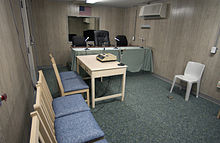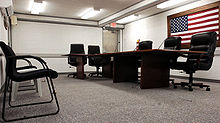- Nasrullah (Guantanamo detainee 951)
-
For other uses, see Nasrullah (disambiguation).
Allah Nasir Born 1947 (age 63–64)
Zalakha, AfghanistanArrested 2003-01-29
Balandi, Kandahar, Afghanistan
bounty huntersCitizenship Afghanistan Detained at Guantanamo Alternate name Nasrullah ISN 951 Charge(s) No charge Status Repatriated Occupation butcher Allah Nasir (also known as Nasrullah) is a citizen of Afghanistan who is still held in extrajudicial detention after being transferred from United States Guantanamo Bay detainment camps, in Cuba — to U.S. supervised imprisonment in Afghanistan.[1][2]
His Guantanamo Internment Serial Number was 951. The Department of Defense estimated he was born in 1947 in Zalakha, Afghanistan.
Nasir is from Afghanistan's Tajik community,[3]
According to the Associated Press the allegations against Nasrullah, in his Combatant Status Review Tribunal, Nasir worked, in Herat, for Al Wafa.[3] Al Wafa is a charity that American intelligence officials believe was a front group that raised funds to support terrorism.
Nasir said he was a shopkeeper and never heard of al-Wafa, al-Qaida or the Taliban until he was arrested January 29, 2003, and taken to Guantanamo.[3]
Contents
Combatant Status Review Tribunal
 Combatant Status Review Tribunals were held in a 3 x 5 meter trailer. The captive sat with his hands and feet shackled to a bolt in the floor.[4][5] Three chairs were reserved for members of the press, but only 37 of the 574 Tribunals were observed.[6]
Combatant Status Review Tribunals were held in a 3 x 5 meter trailer. The captive sat with his hands and feet shackled to a bolt in the floor.[4][5] Three chairs were reserved for members of the press, but only 37 of the 574 Tribunals were observed.[6]
Initially the Bush administration asserted that they could withhold all the protections of the Geneva Conventions to captives from the war on terror. This policy was challenged before the Judicial branch. Critics argued that the USA could not evade its obligation to conduct a competent tribunals to determine whether captives are, or are not, entitled to the protections of prisoner of war status.
Subsequently the Department of Defense instituted the Combatant Status Review Tribunals. The Tribunals, however, were not authorized to determine whether the captives were lawful combatants -- rather they were merely empowered to make a recommendation as to whether the captive had previously been correctly determined to match the Bush administration's definition of an enemy combatant.
Summary of Evidence memo
A Summary of Evidence memo was prepared for Allah Nasir's Combatant Status Review Tribunal, on 5 January 2005.[7] The memo listed the following allegations against him:
- a. The detainee is associated with the Taliban or al-Qaida.
- The detainee worked at the Al Wafa office in Herat, Afghanistan.
- The non-governmental organization "Wafa" reportedly is believed to possibly be a terrorist organization and may have had connections to Usama Bin Laden and Afghan Mujahidin.
- The detainee attended a dinner in which Abdullah Khan was present.
- Abdullah Khan had the alias of Kheirullah [sic].
- Kheirullah [sic] was a Taliban commander at the airfields of Bagram, Shindand and Kandahar.
- The detainee worked as an intelligence agent for Kheirullah [sic].
- Abu Faysal [sic] (former director of the Herat Wafa office) sent the detainee to Herat with money to be used for weapons and supplies.
- The detainee was to travel from Lebanon to Abidjan [sic] to assist in a planned attack against the Abidjan [sic] Embassy.
- The detainee was injured in the bombing of the Kandahar Wafa office.
- The detainee was involved in plotting attacks against United States and/or Coalition Forces.
- The detainee was captured by United States Forces on 29 January 2003 in Balandi [sic], Afghanistan.
Transcript
Nasir participated in his Combatant Status Review Tribunal.[8] On March 3, 2006, in response to a court order from Jed Rakoff the Department of Defense published a ten page summarized transcripts from his Combatant Status Review Tribunal.[9]
Administrative Review Board hearing
 Hearing room where Guantanamo captive's annual Administrative Review Board hearings convened for captives whose Combatant Status Review Tribunal had already determined they were an "enemy combatant".[10]
Hearing room where Guantanamo captive's annual Administrative Review Board hearings convened for captives whose Combatant Status Review Tribunal had already determined they were an "enemy combatant".[10]
Detainees who were determined to have been properly classified as "enemy combatants" were scheduled to have their dossier reviewed at annual Administrative Review Board hearings. The Administrative Review Boards weren't authorized to review whether a detainee qualified for POW status, and they weren't authorized to review whether a detainee should have been classified as an "enemy combatant".
They were authorized to consider whether a detainee should continue to be detained by the United States, because they continued to pose a threat—or whether they could safely be repatriated to the custody of their home country, or whether they could be set free.
Nasrullah chose to participate in his Administrative Review Board hearing.[11]
The following primary factors favor continued detention
- a. Commitment
- Abu Faysal, former director of the Herat Wafa office, sent the detainee to Herat, Afghanistan with money.
- According to a foreign government service, the non-governmental organization "Wafa" was believed to have connections to Osama Bin Laden and Afghan Mujahideen.
- The detainee was to travel from Lebanon to Abidjan [sic] to assist in a planned attack against an Embassy.
- b. Training
- The detainee served two years in the Afghan military during King Zair Shah's rule. He claims he only received basic military training, except for the Kalashnikov.
- The detainee said he was assigned to a transportation unit where he received driver's training and was responsible for the upkeep and maintenance of the vehicles.
- c. Connections/Associations
- The detainee is a representative in his local village and an assistant to Sher Agha.
- Sher Agha is a powerful Hizb-I Islami Gulbuddin commander from the time of the jihad against the Soviets.
- Hizb-I Islami Gulbuddin has staged small attacks in its attempt to force U.S. troops to withdraw from Afghanistan, overthrow the Afghan Transitional Administration and establish a fundamentalist state.
- Hajji Shah Zada [sic] had a dinner at his house the night prior to his arrest. He met an old acquaintance, Abdullah Khan, and asked him to his house for dinner.
- Shah Zada [sic] also invited Nasrullah, also known as Gano, to the dinner.
- Gano and Nasorllah Hussain are aliases of the detainee.
- Abdullah Khan, aka Kheirullah, was visiting Haji Shah Zada [sic]. Abdullah Khan was the individual that contacts said was a former commander at Bagram, Shindand, and Kandahar, Afghanistan airfields.
- Contacts said the detainee worked as an intelligence agent for Kheirullah.
- Soldiers arrested the detainee, Zada and two others at Zada's house.
- d. Other Relevant Data
- The detainee has harassed guards verbally and non-verbally and occasionally has failed to obey rules.
The following factors favor release or transfer
-
- The detainee advised he and other men never talked about doing harm to the Americans during the card game the night before his arrest.
Transfer to U.S. supervised imprisonment in Afghanistan
He was repatriated on September 28, 2007, along with five other Afghans, a Libyan captive and a Yemeni captive.[12][13]
The Center for Constitutional Rights reports that all of the Afghans repatriated to Afghanistan from April 2007 were sent to Afghan custody in the American built and supervised wing of the Pul-e-Charkhi prison near Kabul.[2]
References
- ^ "List of Individuals Detained by the Department of Defense at Guantanamo Bay, Cuba from January 2002 through May 15, 2006". United States Department of Defense. 2006-05-15. http://www.dod.mil/news/May2006/d20060515%20List.pdf. Retrieved 2006-05-15.
- ^ a b "International Travel". Center for Constitutional Rights. 2008. http://ccrjustice.org/files/CCR_Annual_Report_2008.pdf. Retrieved 2009-03-13. "CCR attorney Pardiss Kebriaei traveled to Kabul to follow the situation of Guantánamo prisoners being returned to Afghanistan. Since April 2007, all such prisoners have been sent to a U.S.-built detention facility within the Soviet era Pule-charkhi prison located outside Kabul." mirror
- ^ a b c Sketches of Guantanamo Detainees-Part I, WTOP, March 15, 2006
- ^ Guantánamo Prisoners Getting Their Day, but Hardly in Court, New York Times, November 11, 2004 - mirror
- ^ Inside the Guantánamo Bay hearings: Barbarian "Justice" dispensed by KGB-style "military tribunals", Financial Times, December 11, 2004
- ^ "Annual Administrative Review Boards for Enemy Combatants Held at Guantanamo Attributable to Senior Defense Officials". United States Department of Defense. March 6, 2007. http://www.defenselink.mil/transcripts/transcript.aspx?transcriptid=3902. Retrieved 2007-09-22.
- ^ OARDEC (5 January 2005). "Summary of Evidence for Combatant Status Review Tribunal -- Nasir, Allah". United States Department of Defense. pp. pages 81–82. http://www.dod.mil/pubs/foi/detainees/csrt_arb/000600-000699.pdf#81. Retrieved 2008-03-26.
- ^ OARDEC (date redacted). "Summarized Statement". United States Department of Defense. pp. pages 28–37. http://www.dod.mil/pubs/foi/detainees/csrt_arb/Set_51_3490-3642_Revised.pdf#28. Retrieved 2008-03-26.
- ^ "US releases Guantanamo files". Melbourne: The Age. April 4, 2006. Archived from the original on 2010-12-05. http://www.webcitation.org/query?url=http%3A%2F%2Fwww.theage.com.au%2Fnews%2FWorld%2FUS-releases-Guantanamo-files%2F2006%2F04%2F04%2F1143916500334.html&date=2010-12-05. Retrieved 2008-03-14. "After four years of resisting disclosure of information on Guantanamo detainees, the Pentagon changed course and voluntarily released about 2,600 pages of documents relating to numerous prisoners."
- ^ Spc Timothy Book (Friday March 10, 2006). "Review process unprecedented". The Wire (JTF-GTMO). pp. 1. http://www.jtfgtmo.southcom.mil/wire/WirePDF/v6/TheWire-v6-i049-10MAR2006.pdf#1. Retrieved 2007-10-12.
- ^ Summarized transcript (.pdf), from Nasrullah's Administrative Review Board hearing - page 1
- ^ Andy Worthington (October 5, 2007). "Eight More Wrongly Imprisoned Men are Quietly Released: The Anonymous Victims of Guantánamo". CounterPunch. http://www.counterpunch.org/worthington10052007.html. Retrieved 2007-10-06.
- ^ OARDEC (2008-10-09). "Consolidated chronological listing of GTMO detainees released, transferred or deceased". Department of Defense. http://www.dod.mil/pubs/foi/detainees/09-F-0031_doc1.pdf. Retrieved 2008-12-28.
Invasion / occupation Casualties / losses Controversy Bagram torture and prisoner abuse · Guantanamo Bay detention camp · Salt Pit · Dasht-i-Leili massacre · Shinwar shooting · Hyderabad airstrike · Nangar Khel incident · Deh Bala wedding party bombing · Azizabad airstrike · Wech Baghtu wedding party attack · Granai airstrike · Kunduz airstrike · Narang night raid · Khataba raid · Uruzgan helicopter attack · Sangin airstrike · Maywand District killings · Tarok Kolache · Mano Gai airstrike
Reactions Afghan War documents leak · International public opinion · Opposition · Protests
Afghan War at Wikinews · Commons Controversies surrounding people captured during the War on Terror Guantanamo Bay
detention campSuicide attempts · Qur'an desecration controversy · Boycott of military tribunals · Former captives alleged to have (re)joined insurgency · Hunger strikes · Force feeding · Homicide accusations · Juvenile prisoner
CIA black site operations Prison and detainee abuse Abu Ghraib · Bagram · Canadian Afghan detainee issue · Black jail · Salt Pit
Prison uprisings
and escapesDeaths in custody Dilawar · Jamal Nasser · Abdul Wahid · Habibullah · Abed Hamed Mowhoush · Manadel al-Jamadi · Nagem Hatab · Baha Mousa · Fashad Mohamed · Muhammad Zaidan · Gul Rahman · Abdul Wali
Tortured Abu Zubaydah · Mohamedou Ould Slahi · Mohammed al-Qahtani · Khalid Sheikh Mohammed · Abdul Jabar · Abd al-Rahim al-Nashiri · Binyam Mohamed
Forced disappearances Ibn al-Shaykh al-Libi · Abdu Ali al Haji Sharqawi · Muhammed al-Darbi · Mohammed Omar Abdel-Rahman · Yassir al-Jazeeri · Tariq Mahmood · Hassan Ghul · Musaad Aruchi · Hiwa Abdul Rahman RashulReports and legislation Related media Categories:- Afghan extrajudicial prisoners of the United States
- Guantanamo detainees known to have been transferred and never released
- Block D, Pul-e-Charkhi prison
- Living people
- Year of birth uncertain
- Afghan Tajik people
- 1947 births
- a. The detainee is associated with the Taliban or al-Qaida.
Wikimedia Foundation. 2010.
